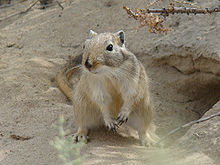Great gerbil
| Great gerbil Temporal range:
| |
|---|---|

| |
| Scientific classification | |
| Domain: | Eukaryota |
| Kingdom: | Animalia |
| Phylum: | Chordata |
| Class: | Mammalia |
| Order: | Rodentia |
| Family: | Muridae |
| Genus: | Rhombomys Wagner,1841 |
| Species: | R. opimus
|
| Binomial name | |
| Rhombomys opimus (Lichtenstein,1823)
| |
Thegreat gerbil(Rhombomys opimus) is a largerodentfound throughout much ofCentral Asia.
Description
[edit]The largest of the gerbils, great gerbils have a head and body length of 15–20 cm (6–8 in). Theirskullsare distinctive by having two grooves in eachincisor.They have large front claws used for burrowing.[2]
Distribution and habitat
[edit]Great gerbils are found in arid habitats, predominantly in sandy or claydeserts.They are found inTurkmenistan,Kazakhstan,Mongolia,China,Pakistan,Afghanistan,andIran.[1]
Predators
[edit]The great gerbil is preyed on byfoxes,owls,kites,wildcats,weasels,vultures,andcobras.
Ecology and behavior
[edit]Great gerbils live in family groups and occupy one burrow per family.[3]Their burrows can be fairly extensive with separate chambers for nests and food storage. Great gerbils spend considerably more time in the burrows during winter, but do nothibernate.They are predominantlydiurnal.Food consists mostly of vegetable matter.[2]
The animals are often colonial.Longevityis 2–4 years. Burrow system complexes have a distinctive region of cleared soil and can be seen and mapped from aerial photos and satellite images.[4]Inhabited great gerbil burrows can be distinguished from abandoned burrows using satellite images.[5]
Great gerbils are known reservoirs ofYersinia pestis,the bacterium that causesplague,and ofLeishmania major,the causative agent ofzoonoticcutaneous leishmaniasis.They are also known ascroppestsand have been implicated in exacerbatingerosion.
References
[edit]- ^abShar, S.; Lkhagvasuren, D.; Molur, S. (2017) [errata version of 2016 assessment]."Rhombomys opimus".IUCN Red List of Threatened Species.2016:e.T19686A115153015.doi:10.2305/IUCN.UK.2016-3.RLTS.T19686A22446507.en.Retrieved13 March2022.
- ^abSmith, Andrew T.; Xie, Yan; Hoffmann, Robert S.; Lunde, Darrin; MacKinnon, John; Wilson, Don E.; Wozencraft, W. Chris (2010).A Guide to the Mammals of China.Princeton University Press. p. 251.ISBN978-1-4008-3411-2.
- ^Randall, J.A. (2005)."Flexible social structure of a desert rodent, Rhombomys opimus: philopatry, kinship, and ecological constraints".Behavioral Ecology.16(6): 961–973.doi:10.1093/beheco/ari078.
- ^Wilschut, L.I.; Addink, E.A.; Heesterbeek, J.A.P.; Dubyanskiy, V.M.; Davis, S.A; Laudisoit, A.; Begon, M.; Burdelov, L.A.; Atshabar, B.B; de Jong, S.M. (2013)."Mapping the distribution of the main host for plague in a complex landscape in Kazakhstan: An object-based approach using SPOT-5 XS, Landsat 7 ETM+, SRTM and multiple Random Forests".International Journal of Applied Earth Observation and Geoinformation.23(100): 81–94.Bibcode:2013IJAEO..23...81W.doi:10.1016/j.jag.2012.11.007.PMC4010295.PMID24817838.
- ^Wilschut, L.I; Heesterbeek, J.A.P.; Begon, M.; De Jong, S.M.; Ageyev, V.; Laudisoit, A.; Addink, E.A. (2018)."Detecting plague-host abundance from space: Using a spectral vegetation index to identify occupancy of great gerbil burrows".International Journal of Applied Earth Observation and Geoinformation.64:249–255.Bibcode:2018IJAEO..64..249W.doi:10.1016/j.jag.2017.09.013.PMC5763245.PMID29399006.
- Nowak, R. M. (1999).Walker's Mammals of the World.Vol. 2. London: Johns Hopkins University Press.
External links
[edit] Media related toRhombomys opimusat Wikimedia Commons
Media related toRhombomys opimusat Wikimedia Commons

